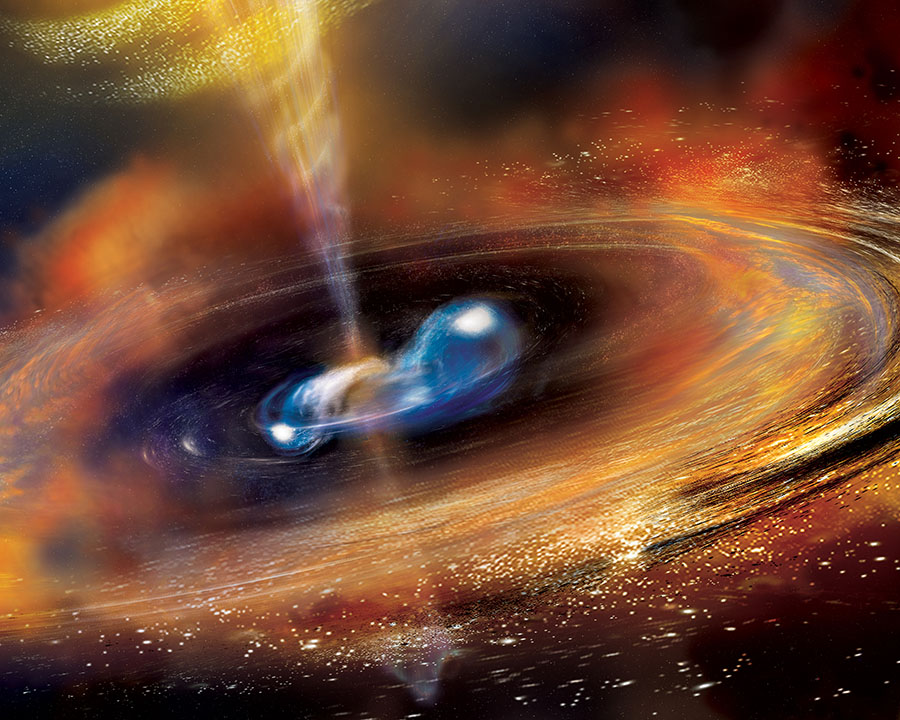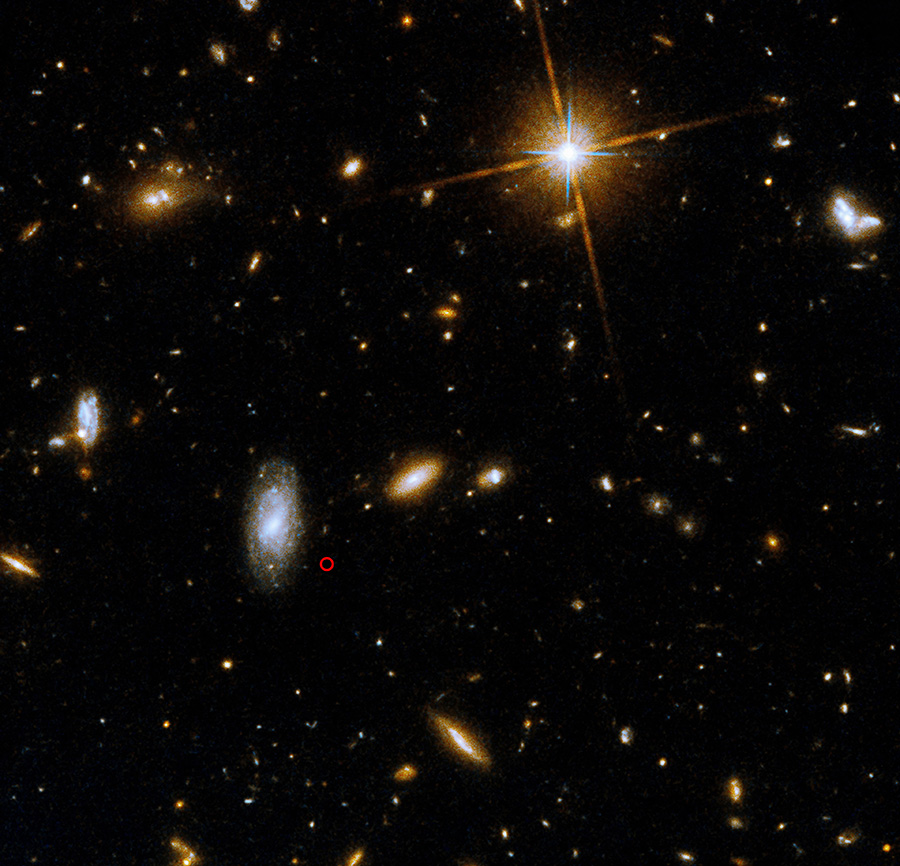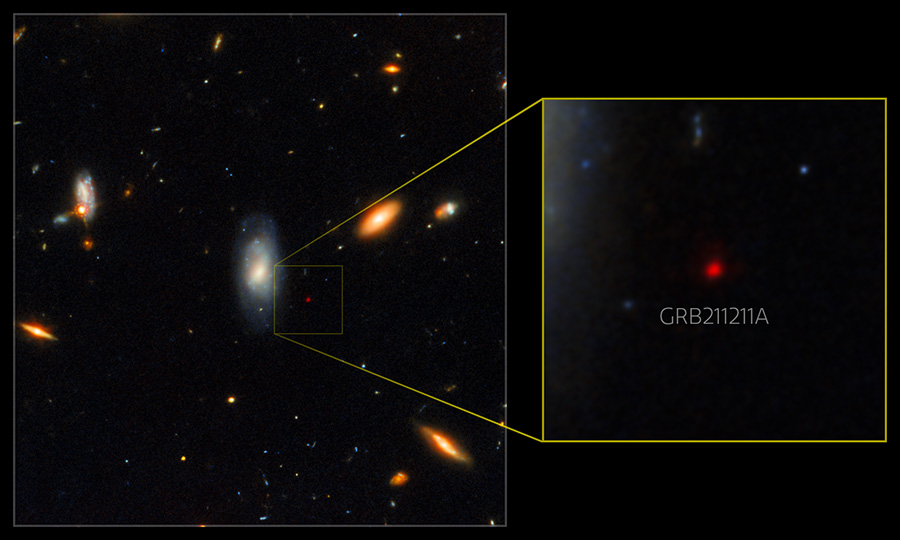Gamma-ray bursts are generally thought to come in two flavors — supernovae or neutron star mergers. But new discoveries are blurring that line.

A. Simonnet (Sonoma State University) / NASA’s Goddard Space Flight Center
A long flare of high-energy radiation usually signals the death of a massive star and the birth of a black hole. But one long gamma-ray burst didn’t come from such a supernova. Astronomers think that GRB 211211A, a minute-long blast of gamma-rays that came from more than 1 billion light-years away, had a different origin.
Not Dead Yet

NASA / ESA / Rastinejad et al. (2022) / Gladys Kober (Catholic Univ. of America)
The Fermi Gamma-ray Space Telescope caught this burst on December 11, 2021, recording a strong pulse of radiation that lasted 13 seconds, followed by a weaker echo 55 seconds long. From its length alone, its identity ought to have been obvious: Long gamma-ray bursts herald supernovae, while shorter gamma-ray bursts signal a stellar merger (typically the whirling together of a pair of neutron stars).
But calling GRB 211211A “long” is akin to calling a tomato a fruit. Yes, the burst was long; however, visible-light observations show no supernova. Instead, the GRB’s change in brightness over time and across wavelengths suggest it’s the site of a merger instead.
And not just any merger: To explain all they see, Jun Yang (Nanjing University, China) and colleagues suggest in Nature this burst marked a collision between a white dwarf and a neutron star. The result of that collision briefly persisted in the form of a more massive and extremely magnetic neutron star known as a magnetar.
The typical magnetar has a field 1 billion times more powerful than anything humans have made, and only a dozen or so of these objects are known in our galaxy. These exotic objects might power more recently discovered radio flashes that pepper the sky.
But the ones that produce gamma rays probably don’t survive long. “In our model, the magnetar is supposed to collapse into a black hole at 6,000 seconds [or 1.6 hours] after the merger,” says team member Binbin Zhang (also at Nanjing University).
Long, Short, and In-Between
Since the discovery of gamma-ray bursts by nuclear compliance satellites in the 1960s, these odd radiation sources have fascinated astronomers. It took awhile to pin down their origin as extragalactic — really extragalactic, since their light typically travels many billions of light-years to Earth.
Astronomers soon saw that while 10% of GRBs are shorter than a second or two, most are longer. These long bursts originate in galaxies rich with new stars. That makes sense if long gamma-ray bursts mark the deaths of massive stars. Massive stars live fast and die young, exploding near near the nursery that gave them birth.
The sites of short gamma-ray bursts, on the other hand, are typically isolated from star formation, indicating a different origin. Like its shorter-burst cousins, the long GRB 211211A was likewise pinpointed to an isolated region of its galaxy.
The nail in the coffin, though, comes from the afterglow, the longer-lasting emission that follows the gamma-ray flare. Eleonora Troja (University of Rome) and Jillian Rastinejad (Northwestern University) led follow-up observations, reported in two separate articles in Nature (linked here and here). They report that, relative to gamma-ray and X-ray emission, there’s far more visible-light and infrared emission than expected if this were the birth of a black hole. Instead, the longer-wavelength emission became bright enough to suggest that what astronomers were seeing was a kilonova, the explosion that follows a stellar merger.
Alessio Mei (Gran Sasso Science Institute, Italy) and his group also report in Nature additional evidence for a kilonova in the nature of the high-energy radiation.

International Gemini Observatory / NOIRLab / NSF / AURA / M. Zamani; NASA / ESA
“Just as a supernova links long gamma-ray bursts to the collapse of massive stars, a kilonova is the smoking gun for a compact binary merger,” writes Luigi Piro (INAF, Italy) in an accompanying perspective article in Nature.
A Merger of a Different Kind
There’s a reason that astronomers have deemed long gamma-ray bursts to have a different origin than shorter bursts, though. The gamma rays from stellar mergers are thought to come from the disk of material that temporarily surrounds and feeds the merged star. Two colliding neutron stars, however, make a disk too small to power a burst longer than a second.
So Yang and colleagues propose a twist on the story: What if, instead of two neutron stars, what collided here was a neutron star and a white dwarf? And what if their merger briefly made a magnetar instead of collapsing immediately into a black hole? Then the disk would last longer, long enough to power 13 seconds of gamma-ray radiation.
The short-lived magnetar’s rapid spin and strong magnetic field might then blow huge plasma-filled bubbles, powering another 55 seconds of weaker gamma rays.
White dwarfs and neutron stars must merge all the time in the universe — far more often, in fact, than pairs of neutron stars. The researchers suggest that only a small fraction of these have a white dwarf and a neutron star with almost the same mass, creating the conditions necessary for a gamma-ray burst.
However, Troja's team disagrees that the observations match that of a white dwarf merger. "Therefore I'd say that the origin of these long GRBs is still very much open and debated," Troja says.
One of a Kind?
This peculiar gamma-ray burst isn’t the first to break the rules. In fact, the field has a saying: “If you’ve seen one gamma-ray burst . . . you’ve seen one gamma-ray burst.” In other words, every GRB is unique in some way.
However, this burst isn’t the first merger-driven GRB to masquerade as a supernova-driven GRB. Neil Gehrels (NASA Goddard) and colleagues reported another such burst in 2006, GRB 060614. Initially classified as long, astronomers later determined that that burst, too, was a merger-driven GRB with extended emission.
More recently, Nuria Jordana-Mitjans (University of Bath, UK) and colleagues found the opposite: a short burst, GRB 180618A, with unexpectedly long emission. Published in the Astrophysical Journal, this GRB also seems to have a short-lived magnetar as its source.
The next campaign for gravitational-wave detections, coming online in March 2023, may well find more exotic mergers. “With so many pieces of the puzzle coming together,” Piro writes, “it won’t be long before the origin of these peculiar flashes is revealed.”
Editor's note (Dec. 9, 2022): Information was added to clarify the contributions from all four papers published in Nature on this gamma-ray burst.
 0
0









Comments
You must be logged in to post a comment.